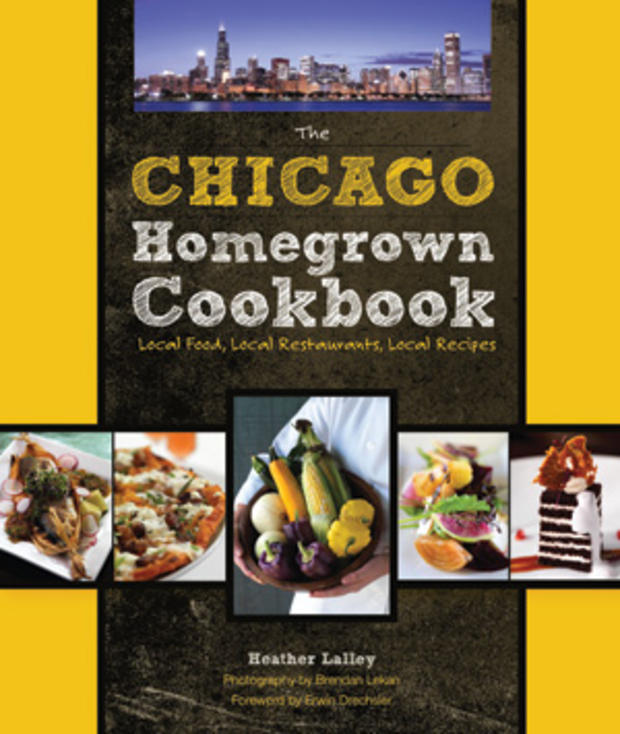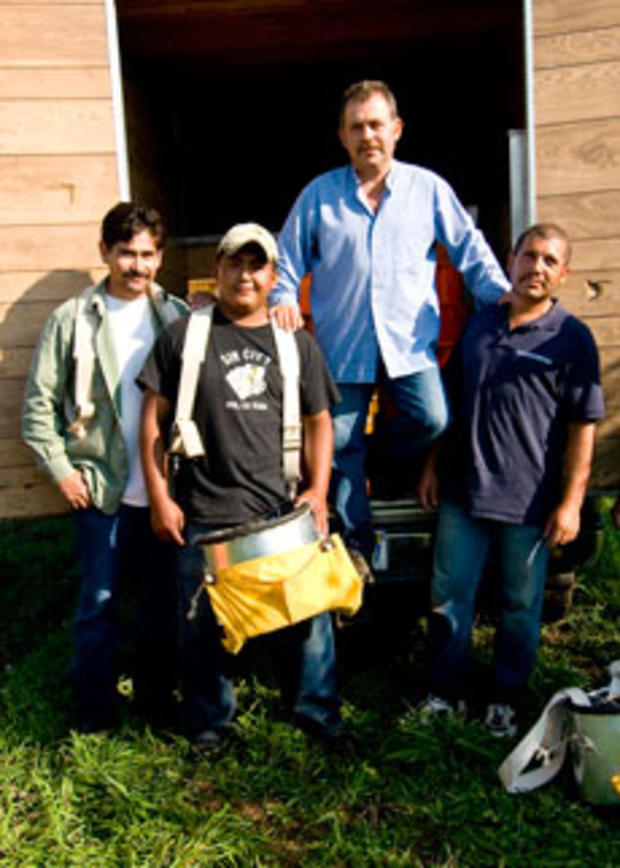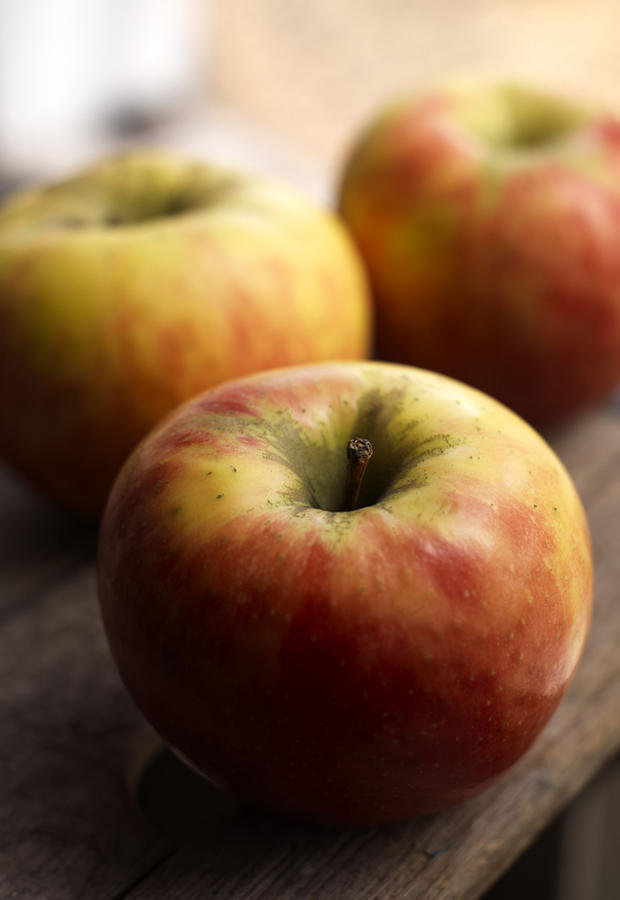Celebrating Chicago Homegrown Food
The new book Chicago Homegrown Cookbook: Local Food, Local Restaurants, Local Recipes (Voyageur Press) by Heather Lalley celebrates the best farm-to-table restaurants in the Windy City, profiling 30 chefs who work together with local farms to bring locally grown food to their menus, and providing recipes from their kitchens.
One of the chefs profiled in the book is also one Chicago's most celebrated chefs, Rick Bayless of Frontera Grill, who was one of the first in the city to begin looking for his ingredients close to home. But he came of age at a time when there was a great cultural identity crisis surrounding locally grown foods. In Chicago Homegrown, he tells the story behind his relationship with local farmers and serves up a delicious recipe for cajeta apple tarts.
Bayless, who grew up in Oklahoma City, remembers his Depression-era parents and grandparents planting, canning, and preserving. "They were always planting a garden, always celebrating the different things that were in season," he says.
At the same time, though, there was a different kind of "green revolution" going on, in which most everything was grown with insecticides and fertilizers. Frozen foods became modern, must-have items.
He recalled his jam-making grandmother beaming with pride when she bought a big chest freezer.
"She was so incredibly proud of this deep freeze," he says. "She did fill it with some of her own stuff. But she was really happy when people could see her pull out the BirdsEye peas. She was conflicted."
Bayless sided more with the hippies who were building compost piles and cultivating sourdough starters to bake bread. It's a philosophy he carried with him when he opened his first Chicago restaurant—Frontera Grill—in 1987.
There was little infrastructure for local food in Chicago at the time, but Bayless thought locally sourced foods might help set him apart. (In fact, many high-end restaurants at the time promoted their exotic ingredients from far away, he says.) So, he went to area farm stands in search of strawberries—his first local ingredient.
That's when Bayless first got to know farmer Mick Klug, who would deliver strawberries to Frontera.
"We made a pact at that time that the only strawberries on our menu would be locally grown strawberries," Bayless says. "It took us a long time and a huge amount of dedication to get to the place where we could actually have a significant amount of local stuff on the menu. For the last ten years now, during the height of the season, we're 90 percent all-local ingredients." With Bayless' three incredibly popular Chicago restaurants—Frontera Grill, Topolobampo, and XOCO—maintaining good relationships with farmers has been essential when ordering such massive quantities.
"They are our partners," he says. "We consider them partners in the restaurant."
As further evidence of his commitment to local farmers, Bayless formed the Frontera Farmer Foundation, which began as a no-interest loan program for growers to buy equipment to increase production. The program eventually became a foundation, which has since given away three-quarters of a million dollars in small grants to food producers.
"We have really helped jump-start the great local agriculture and put it to a level that people can make a living at it," he says.
Bayless first met Klug about nineteen years ago at the farmers' market in Lincoln Park. He now buys pound after pound of raspberries, black raspberries, blackberries, peaches, gooseberries, pluots, apples, pears, and asparagus from Klug.
Bayless was Klug's first chef customer. As Bayless started buying more produce, "that's when we realized there was a market to cater to restaurants," Klug says.
Klug, who was born and raised on the farm in south St. Joseph, Michigan, went through a phase after high school in which he didn't know if farming was for him.
"Farming is a struggle," he says. "It's seven twenty-fours. It's pretty intense."
But other factors won out: "The flexibility of being your own boss, your own worker, and working with the land," he says. "It's very rewarding when you plant something and it grows."
Klug now owns 40 acres and rents an additional 80 acres of land. Over the years, he has adjusted his crops a bit to meet the needs of chefs.
"We have upped our acreage in asparagus; that is getting to be a big seller," Klug says. "We're always planting more Honeycrisp apples. We're always looking for more varieties of peaches to try. We're planting more Asian pears."
It has been a bit surreal over the years to work so closely with such a well-known chef, Klug says. "There's people taking our pictures with him," he says. "He has really done well for himself. He's true blue. What he does is what he believes in."
Recipe: Rustic Cajeta Apple Tarts with Berry "Salsa"
From Rick Bayless
The easy, foolproof pastry for these rustic tarts was inspired by a recipe from Rose Levy Beranbaum's remarkable The Pie and Pastry Bible.
Makes 6 individual tarts
1 1/3 c. (6 oz.) all-purpose flour
1/8 tsp. baking powder
1/8 tsp. salt
6 oz. (3/4 c.) unsalted butter, cold, cut into small pieces
1 3-oz. package cream cheese, cold, cut into small pieces
1 1/2 tsp. cider vinegar
1 1/2 tbsp. ice water
5 medium (about 2 lb. total) firm cooking apples, such as Gala or Granny Smith
1 tsp. lime or lemon zest, finely chopped
1 c. cajeta, store-bought or homemade
2 c. berries, such as raspberries, blackberries, or hulled, sliced strawberries (defrosted quick-frozen berries will work)
1–2 tbsp. sugar, to taste
3/4 c. homemade crema, crème fraîche, or sour cream thinned with a little milk (optional)
In a food processor, combine flour, baking powder, and salt. Pulse to mix thoroughly. Add 4 oz. (1/2 c.) of butter and all the cream cheese, then pulse 5 or 6 times until the mixture looks like coarse crumbs. Drizzle the vinegar and ice water over the dough, and pulse 3 times to bring the mixture together into rough clumps. Turn out onto your work surface, divide into 6 parts, and roll each into a ball. Place the balls on a plate, cover with plastic wrap, and refrigerate for about 45 minutes.
Peel and core the apples, then cut them into 1/2-in. cubes. You should have about 6 c.
In a large (12-in.) heavy skillet (preferably nonstick), heat the remaining 2 oz. (1/4 c.) of butter over medium-high heat. Add the apples and stir nearly constantly as they cook, first releasing their juice, then softening and browning as the juice evaporates, about 8–10 minutes. When the apples are soft (if you've chosen the firm-cooking apples, they won't be falling apart) and browned, add 1/2 tsp. of the lime or lemon zest and 1/4 c. of the cajeta. Stir for a minute or two, then remove from the heat. Scoop the apple mixture onto a baking sheet to cool to room temperature, about 15 minutes.
While the apples are cooling, roll out each ball of dough into a 6-in. round on a lightly floured work surface. Transfer the pastry rounds to a parchment-covered or lightly oiled baking sheet, leaving about 2 in. between the rounds. If the apples haven't cooled to room temperature by this point, cover the pastry rounds with plastic wrap and refrigerate.
Spoon 1/3 c. of the filling onto the center of each pastry round, leaving a 1 1/2-in. border all around. Carefully fold the dough edges up over the filling toward the center, gently pleating the dough as necessary. If time allows, place the baking sheet in the freezer for about 20 minutes.
Heat the oven to 400°F. Bake the tarts until richly golden and crispy, about 20–25 minutes. Remove from the oven and drizzle a generous 1/2 tbsp. of the remaining cajeta into the center of each tart. Cool on a wire rack.
In a small bowl, mix the berries with the remaining 1/4 tsp. of lime or lemon zest and the sugar. Mash the mixture slightly to crush some of the berries. Let the mixture stand a few minutes to meld the flavors.
Serve the tarts warm with a spoonful or two of the optional crema or sour cream, the berry "salsa," and a little drizzle of the remaining cajeta.
Working ahead: Both the dough and filling can be made 3 days ahead if kept well-covered and refrigerated. Formed tarts can be held for 6 hours or so in the refrigerator (skip the freezing step, instead simply cover them with plastic and refrigerate). These tarts are best served within 3 or 4 hours of their baking. Rewarming cool tarts gives them renewed life.
Chicago Homegrown Cookbook: Local Food, Local Restaurants, Local Recipes is now available at bookstores. Chapter and recipe excerpted with permission from Voyageur Press.







